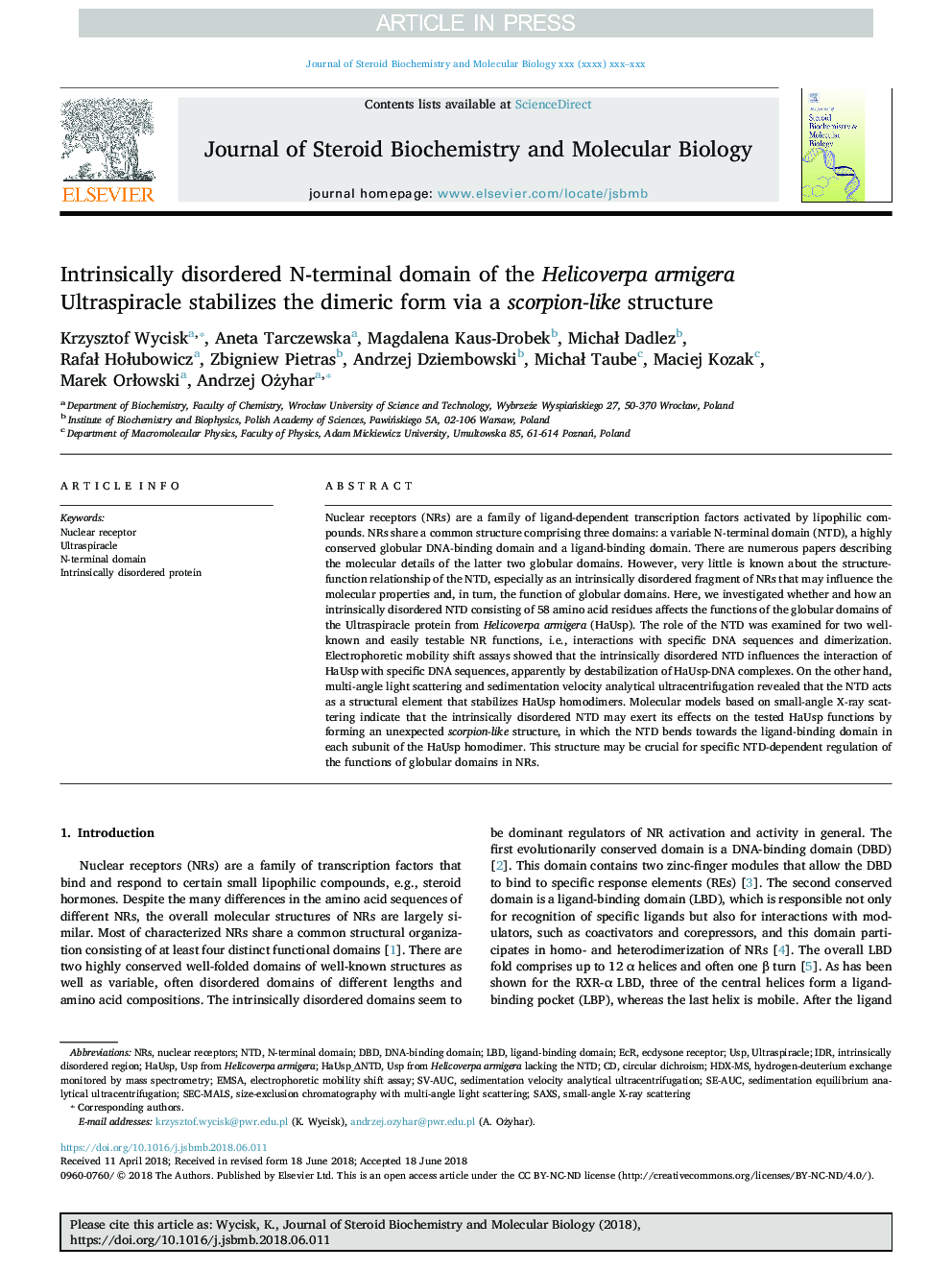| کد مقاله | کد نشریه | سال انتشار | مقاله انگلیسی | نسخه تمام متن |
|---|---|---|---|---|
| 8961916 | 1646524 | 2018 | 17 صفحه PDF | دانلود رایگان |
عنوان انگلیسی مقاله ISI
Intrinsically disordered N-terminal domain of the Helicoverpa armigera Ultraspiracle stabilizes the dimeric form via a scorpion-like structure
دانلود مقاله + سفارش ترجمه
دانلود مقاله ISI انگلیسی
رایگان برای ایرانیان
کلمات کلیدی
LBDEMSAsize-exclusion chromatography with multi-angle light scatteringSAXSSEC-MALSHauspUltraspiracleSV-AUCHDX-MSUSPIDRDBDNRSNTDECRElectrophoretic mobility shift assay - آزمون تحرک تحرک الکتروفورزsedimentation velocity analytical ultracentrifugation - اولتراسوند سانتریفیوژ تحلیلی سرعت رسوبN-terminal domain - دامنه N-terminalDNA-Binding Domain - دامنه اتصال DNAligand-binding domain - دامنه اتصال لیگاندcircular dichroism - رنگ تابی دورانیintrinsically disordered region - منطقه ذاتا ناسازگار استSmall-angle X-ray scattering - پراکندگی اشعه ایکس با زاویه کوچکIntrinsically disordered protein - پروتئین ناسازگار ذاتیEcdysone receptor - گیرنده اگزایسونNuclear receptor - گیرنده هستهای، گیرندههای هستهایnuclear receptors - گیرندههای هستهای
موضوعات مرتبط
علوم زیستی و بیوفناوری
بیوشیمی، ژنتیک و زیست شناسی مولکولی
زیست شیمی
پیش نمایش صفحه اول مقاله

چکیده انگلیسی
Nuclear receptors (NRs) are a family of ligand-dependent transcription factors activated by lipophilic compounds. NRs share a common structure comprising three domains: a variable N-terminal domain (NTD), a highly conserved globular DNA-binding domain and a ligand-binding domain. There are numerous papers describing the molecular details of the latter two globular domains. However, very little is known about the structure-function relationship of the NTD, especially as an intrinsically disordered fragment of NRs that may influence the molecular properties and, in turn, the function of globular domains. Here, we investigated whether and how an intrinsically disordered NTD consisting of 58 amino acid residues affects the functions of the globular domains of the Ultraspiracle protein from Helicoverpa armigera (HaUsp). The role of the NTD was examined for two well-known and easily testable NR functions, i.e., interactions with specific DNA sequences and dimerization. Electrophoretic mobility shift assays showed that the intrinsically disordered NTD influences the interaction of HaUsp with specific DNA sequences, apparently by destabilization of HaUsp-DNA complexes. On the other hand, multi-angle light scattering and sedimentation velocity analytical ultracentrifugation revealed that the NTD acts as a structural element that stabilizes HaUsp homodimers. Molecular models based on small-angle X-ray scattering indicate that the intrinsically disordered NTD may exert its effects on the tested HaUsp functions by forming an unexpected scorpion-like structure, in which the NTD bends towards the ligand-binding domain in each subunit of the HaUsp homodimer. This structure may be crucial for specific NTD-dependent regulation of the functions of globular domains in NRs.
ناشر
Database: Elsevier - ScienceDirect (ساینس دایرکت)
Journal: The Journal of Steroid Biochemistry and Molecular Biology - Volume 183, October 2018, Pages 167-183
Journal: The Journal of Steroid Biochemistry and Molecular Biology - Volume 183, October 2018, Pages 167-183
نویسندگان
Krzysztof Wycisk, Aneta Tarczewska, Magdalena Kaus-Drobek, MichaÅ Dadlez, RafaÅ HoÅubowicz, Zbigniew Pietras, Andrzej Dziembowski, MichaÅ Taube, Maciej Kozak, Marek OrÅowski, Andrzej Ożyhar,